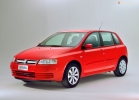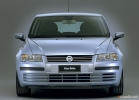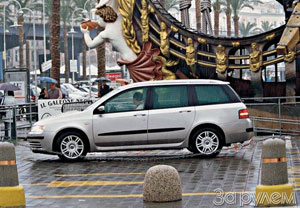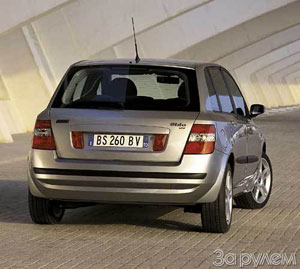Test Drive Fiat Stilo 5 Doors 2001 - 2006 Hatchback
Italian Mustang
In one of the past numbers, you could already read the material about the new Fiat Stilo - the first car, created as part of the production reorganization program and the indigenous change in the Fiat brand in the eyes of buyers. About what happened from it, you could learn everything in the same material ...One of the minuses of Fiat Stilo 5D was the lack of any highlight in the external design, the very characteristic feature, thanks to which all the golf and the 307s began recognizable and popular. The car seems to be good, but the look to cling to nothing. And I personally, to be honest, the five-door stilo did not like at all. Pretty peculiar appearance, 1,2-liter engine in the database, driving quality and acoustic comfort is not at the highest level. But as much as the five-door car did not like, I liked his three-door counterfeit, here's really completely different cars under one name! And if the majority of automakers only say that sports three-door and five-door family versions of their models have a different character, then Fiat on the example of Stilo models and Stilo ABARTH managed to clearly demonstrate how these versions can really be unlike each other.
Let's start with the design. Despite the fact that many firms use such a solution when the three- and five-door versions of one model are very much different in the design plan, Fiat really managed to create practically no model on each other. You can even say that in the five-door hatchback Stilo Abarth looks only in one perspective: in front. In everything else, starting from the profile and ending with the rear lamps is very interestingly designed, it is a completely original car. Even in such trifles like a drawing of wheeled disks ... Naturally, the time of the most sporting modification was laid in the model range, it should look like, respectively, fiero. And it fully complies with his class: the profile looks much more rapidly in the five-year, reminding the new Honda Civic Type R, and something is typically Italian in the back. Rear lights are just a special direction in modern automotive design. Unusual, unusual, but as beautiful. If you lie with the color of the car itself, then it will look at no worse than the fierce central motor supercar.
Separately, I would like to say about the unique gearbox selesepeed - it is installed on the version of Abarth as standard equipment, and the mechanics are not offered for this car at all. And to be honest, it was not an advantage for me to get acquainted with the car for me: all the same with a mechanical transmission machine and cheaper, and in any case it is more suitable for an active drive, and it turns out that in many respects the car dynamics depends on how much Perfect and brought to mind transmission. But after I traveled for some time on Abarth 2.4 Selespeed, without a shadow of doubt I can declare: the mechanics are really needed here only in order to increase the number of versions proposed. She, transmission, really turned out to be very good, and even in this fierce car, her presence looks like granted. And if most sports models put the mechanics only because ordinary automata can kill the dynamics even in the most powerful car, then Abarth version designers decided to kill two hares at once: in his gearbox selesepeed, they tried to connect the benefits of both types of transmissions. The principle of action selesepeed is simple. Structurally, it is an ordinary mechanical gearbox with clutch, only by all processes in this case, the solenoids are made. Approximately the same scheme applies to more accessible Opel Corsa, and in exotic SMART. And in both of these cases, after the test, the main claims had the main claims for the operation of electronics, the controlling work of the transmission. If briefly, the algorithm for the operation of such a transmission resembles the actions of the novice driver: the clutch is not on time or will release too dramatically, it switches too early or later. In general, there were enough problems with those two cars, and the only excitement of the technical imperfection of their transmissions could serve as a low price, although in the case of SMART you cannot say this.
Naturally, familiarized with the design of the Fiatovsky transmission, I came in absentia to the conclusion that about the same picture expects us and in this case. And even more so: there were suspicions that, in combination with a powerful and treagoral engine, such a transmission would be generally a thing of incompatible ... And as well, that I was wrong. Transmission Stilo Abarth is indeed one of the best among the same type, and in this considerable merit of those who taught it to ride and work.
Let's start in order, from the start process. In both of the above competitors, it occurs at about the same algorithm. At idle, the car does not roll like on a machine, but it stands on the spot, and the movement begins only when the driver slightly presses for gas. After that, the electronics begins to slowly stretch the clutch, and very slowly, because, on the one hand, it should make the process of starting from the scene as soft as possible, and on the other - not to stretch it in time. But the electronic foot released the clutch completely, and the next moment the car, depending on whether the gas pedal was pressed or released, or sharply twitching forward, or no less sharply peeped his nose. Approximately the same thing happens on acceleration: if only slightly adjust the accelerator pedal, then the machine will accelerate relatively smoothly, but incredibly long, and if, on the contrary, to keep the pedal squeezed to the floor, then with the maximum acceleration, the car twisted on the shifts as paralyc. The most interesting thing is that in both of these cases the electronics does not try to interfere with the operation of the fuel injection system: when switching, if the driver did not adversely dump the speed at this moment, the tachometer arrow jumps up to the red zone, and the car creates as if the car is really a student, For the first time we went on my own.
Such a detailed story about the work of transmissions of competitors was needed so that you fully appreciate the perfection of Selespeed transmission.
Let's start with the fact that nothing of the above features from Fiat Stilo Abarth is not observed: the transmission works so clearly and timely, you might think that it provides 50-60 adaptive modes of operation. Although who knows maybe it is. Considering how many FIAT funds spent on the development of the Stilo family and the modernization of production, it would be no wonder.
The starting process resembles anything, but not only the transmissions of this type tested by me earlier. The machine rows from the place easily and without any podging, and the speed of the clutch and the softness of its inclusion is selected so optimally that sometimes it is even impossible to determine when it turned on completely completely. The transition to increased gear also occurs quickly and quietly: the car does not even have time to be peaked, only the tachometer arrow changes its position. By the way, like competitors, Stilo Abarth SeleSpeed \u200b\u200bis provided both fully automatic and manual operation, when the driver can independently choose transmission. Only if competitors translate the checkpoint in manual mode of operation every time after the car was muffled, then in Stilo it will work in that mode in which it was left before. Modes are switched inconsistent with the AUTO key, fed to the left of the PPC lever. By the way, about the lever - the switching scheme is drawn on his head, according to which, to turn on the mode, the movement is enough just to swing the lever to the left, and you can turn it on the swinging or reduced transmission to the swings to it. But everything turned out to be a little wrong: it is really possible to change the transfer to the lever back and forth, but the movement mode turns on ... Also tilt the lever forward. In general, he shifted a little, I still got up with the algorithm of work Selespeed, and here the most interesting thing began ... You know why many riders and just experienced drivers do not like the automata, whether they are at least three times perfect? Because none of them, by virtue of constructive features, in any of the modes of operation, does not provide a tough connection of the leading wheels with the engine - frictional frictions, depending on the mode of operation, can slip more or less, but it is inevitably inevitable in any case, So, the rigid connection is impossible. And this, in turn, suggests that many receptions of driving a powerful car, ranging from passing by fan and ending the elementary driving in a slippery ground or snow, can be forgotten.
This is something good selesepeed: it provides exactly the same link between the engine and leading wheels, which only happens in cars with mechanical gearbox. Naturally, it is much more convenient, especially when driving at high speeds, since there are no losses on the slip of the frictional, and the acceleration is obtained maximum. But the most important thing is that at the same time the creators of Selespeed managed to make the gearbox work simultaneously and quickly and smoothly. In any mode of switching, it takes almost imperceptibly for passengers, although the driver can still feel it on a short-term reduction in acceleration intensity. The only complaint is in a fully automatic mode of operation, if you sell the gas pedal to the polish, the kick-down is triggered too long and sharply. But for such situations where the maximum return and complete control over the machine is required, and manual operation is provided. To turn on, as I said, it is enough to press the AUTO key on the central part of the console. Now you can change the transfer yourself, providing either the maximum acceleration, or saving fuel, and it can be done differently: when moving, you can click on the transmission to the transmission to the transmission, and, for example, in turn, when you do not fall on the lever, you can swing Lever forward-back. Now you do not need any kick-down dowes, and before tense overtaking you yourself turn on the reduced gear.
It so happened that almost the entire Test of the Fiat Stilo Abarth SeleSpeed \u200b\u200bwas slowly turned into a description of the device, the principles of work and the characteristics of its transmission. But it is really almost the most interesting thing that is in this car. About the dynamics of overclocking how many are neither telling, and the numbers in the catalog still say for themselves. ABARTH, by the way, with this indicator full order: acceleration from place to hundreds takes 8.5 seconds. Controllability? There is a small question regarding the coupling properties of the tires on the wet asphalt, and in all the rest - full order. Maybe in this car there are some more disadvantages like strong noise all the same tires at a speed of about 100 km / h, but against the background of general splendor, which will delight its owner Fiat Stilo Abarth, they are simply invisible. It is said that for the good price, the buyer can forgive his future horse and poor-quality finish, and noise in the cabin, and some more sufficiently serious shortcomings.
Looking at the price tag version of Abarth, also begins to involuntarily seem that he will have to forgive much: a car with a 2.4-liter motor and non-mechanical gearbox simply cannot cost so cheap. Now it turns out that it can ...
(+) Stylish, powerful design, dear and convenient interior, powerful engine, smart gearbox, relatively affordable price.
(-) Uncomfortable interconnection of the handbrake and the central front armrest, noise from the tires.
Text: Pavel Kozlovsky
A source: Autogase / N 22 (368) dated 19.06.02
Test Drives Fiat Stilo 5 Doors 2001 - 2006
Fiat Stilo Crash Test 5 Doors 2001 - 2006
Crash Test: Details27%
Driver and passengers
8%
Pedestrians
37%
Children-passengers









